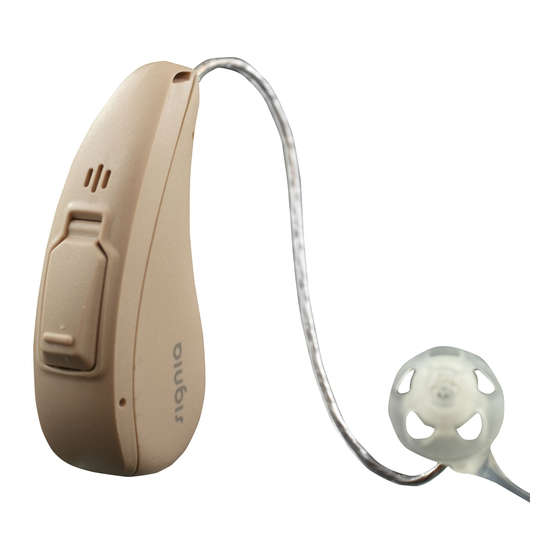
Table of Contents
Advertisement
Advertisement
Table of Contents

Summary of Contents for Siemens Cellion primax
- Page 1 Cellion primax Guide for Hearing Care Professionals Hearing Systems...
-
Page 2: Table Of Contents
Content Introduction Before and after fitting Assembling Activating Charging Connecting Noting the serial number Disconnecting Replacing the housing Disassembling Assembling Important safety information General warnings Disposal Further information Storage periods Symbols used in this document ... -
Page 3: Introduction
Introduction This guide is intended for Hearing Care Professionals. It provides important information on hearing instruments with permanently built‑in power cells (lithium‑ion batteries). CAUTION It is important to read this guide, the user guide and the safety manual thoroughly. Follow the safety information to avoid damage or injury. -
Page 4: Before And After Fitting
B efore and after fitting You have to prepare the hearing instruments before you can start fitting. A ssembling A power cell is installed in every hearing instrument on delivery. There is no need to insert a battery. Attach the suitable receiver unit and a suitable ear piece to the hearing instruments. The procedure is the same as for any other of our RIC hearing instruments. -
Page 5: Charging
Charging The hearing instruments are pre-charged on delivery. They should have sufficient power for a first fitting session. We recommend to fully charge the hearing instruments before first fitting and handover to the client. A full charging cycle takes approximately 4 hours. Follow the operating conditions in both the hearing instrument's and the charger's user guide. C onnecting You can either fit the hearing instruments wirelessly with ConnexxLink or use the CS44 connection beneath the push button: Use the included tool to lift the push button. Do not use sharp tools. Plug the CS44 cable as shown in the picture. -
Page 6: Noting The Serial Number
N oting the serial number You can find the hearing instrument's serial number beneath the push button, next to the CS44 connection. D isconnecting Depending on the charging status, the hearing instruments may switch off after being disconnected from the programming device. This safety feature avoids deep‑discharge of the power cell. To turn the hearing instruments back on: Put them into the powered charger for a moment. After removal from the charger the hearing instruments are automatically turned on. Or press the push button for several seconds. -
Page 7: Replacing The Housing
Replacing the housing NOTICE This maintenance task must be performed by the Hearing Care Professional. Disassembling Remove the receiver unit and the axles. Insert the included tool into the front end of the hearing instrument and detach the bottom housing. You may feel some resistance since the hearing instrument sits firmly in the bottom housing. - Page 8 Use the included tool to remove the top housing. Do not use sharp tools. To remove the push button, first remove the axle then lift the push button.
-
Page 9: Assembling
Assembling Place the push button on the instrument and insert the axle. Install the top housing. Ensure that on both sides of the hearing instrument the notches of the top housing match the marked lines. The top housing clicks noticeably in place. Install the bottom housing from back first, then push in the front. - Page 10 Attach the axles. Note the different lengths and diameters of the axles. Check the joint between top and bottom housing. It must be even and very narrow. If it is uneven or wide, the silicone wrapper may not sit correctly. Disassemble the hearing instrument again and improve the position of the silicone wrapper. Attach the receiver unit.
-
Page 11: Important Safety Information
Important safety information This section contains important safety information regarding the power cell. For more safety information, refer to the safety manual and the user guide supplied with the hearing instruments. NOTICE Maintenance tasks must be performed by the Hearing Care Professional. General warnings WARNING A power cell (lithium‑ion rechargeable battery) is permanently built into your hearing instrument. ... -
Page 12: Disposal
Avoid short circuiting of power cells: Power cells removed from their packaging should not touch each other. Handle the power cells with great care: ● Do not drop or damage them (e.g. crush, pierce or open them). ● Protect them from moisture and do not immerse them in water. ● ... -
Page 13: Further Information
F urther information S torage periods Unused power cells and hearing instruments loose their charge. Observe the following storage periods to avoid deep‑discharge: ● Power cells and hearing instruments that have not been activated or used can be stored up to 15 months after production date. The production date is printed on the power cell: Day (DD), month (MM) and last digit of the year (Y) of production is printed on the power cell. Example: 21056XX = 21st of May 2016. - Page 16 Legal Manufacturer Signia GmbH Henri-Dunant-Strasse 100 91058 Erlangen Germany Phone +49 9131 308 0 Manufactured by Signia GmbH under Trademark License of Siemens AG. Document No. 03030-99T03-7600 EN Order/Item No. 109 423 16 0123 Master Rev04, 12.2016 © Signia GmbH, 12.2016 www.signia-hearing.com...











Need help?
Do you have a question about the Cellion primax and is the answer not in the manual?
Questions and answers